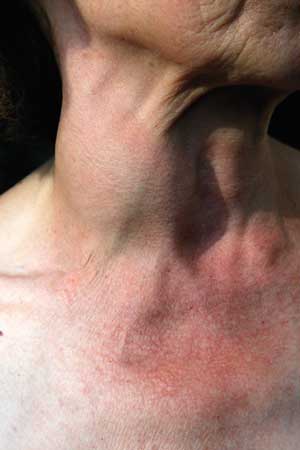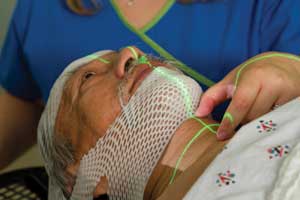Thanks to laser surgery refinements, “your life or your voice” is a choice fewer people in the world have to face.
In the US alone, 10,000 people are diagnosed each year with laryngeal carcinoma, according to the American Cancer Society. This cancer affects the vocal cords and the connective tissues surrounding them. Of these, nearly 4000 will die of the disease. Smoking tobacco is the major force behind laryngeal cancer, also known as glottic cancer, although alcohol consumption seems to magnify the effect smoking has.
When a patient is first diagnosed with glottic cancer, the immediate goal is cure of the disease. Secondarily, the physician strives to preserve the patient’s voice and ability to swallow well, which both can be dramatically affected after chemical, radiation or surgical treatment. Laser microsurgery is becoming an effective tool to help doctors meet these goals.
 Glottic cancer treatment has evolved from complete removal of the larynx (laryngectomy) to radiotherapy, chemotherapy and partial laryngectomy, as well as combinations of these. Today, total laryngectomies are seldom performed unless chemotherapy and radiation have failed. Tumor stage is the primary factor that determines the treatment chosen, although available facilities and patients’ structure – such as their general health or whether they naturally have a restricted airway – also are considered.
Glottic cancer treatment has evolved from complete removal of the larynx (laryngectomy) to radiotherapy, chemotherapy and partial laryngectomy, as well as combinations of these. Today, total laryngectomies are seldom performed unless chemotherapy and radiation have failed. Tumor stage is the primary factor that determines the treatment chosen, although available facilities and patients’ structure – such as their general health or whether they naturally have a restricted airway – also are considered.
Early-stage tumors generally are treated with surgical excision of the least amount of tissue practical. More advanced tumors receive chemotherapy or radiation over a span of several weeks. In recent years, CO2 laser-based endoscopic surgery has been investigated as a potential replacement for chemotherapy and radiotherapy for T3-stage glottic cancer.
The main benefits of laser surgery for glottic cancer are speed and precision, said Dr. Mohssen Ansarin of the European Institute of Oncology in Milan, Italy. The technique also does not rule out further treatments, should the physician deem radiotherapy, open neck surgery or a second laser microsurgery necessary as a follow-up.
Laser surgery also has lower complication rates, comparable or better treatment outcomes, and lower hospital costs due to shorter patient stays. For certain patients, the technique also has fewer contraindications to treatment than traditional surgery, chemotherapy or radiation therapy.

Compared to other options, laser surgery offers comparable or better treatment outcomes for patients, ease of use for surgeons, lower hospital costs and fewer contraindications that would preclude some patients from receiving treatment.
Researchers at Royal Derby Hospital in Derby, UK, completed a retrospective study last year of several patients who had undergone the procedure, which is formally called transoral laser microsurgery. Twenty-two patients, all with either Tis, T1 or T2 stage cancer (see sidebar above for stage definitions), were evaluated for response to treatment, including success of tumor resection, restoration of the patient’s voice and changes in the patient’s ability to swallow.
Five years after surgery, the rate of successful preservation of the larynx was 89 percent for those patients with T1 tumors and 56 percent for those with T2. Their mortality rate was 4.5 percent, and overall disease-free survival rate was 77 percent, which is comparable to patients who had undergone radiotherapy, according to the researchers. Both swallowing and voice preservation outcomes were comparable to or better than those resulting from radiotherapy. The results appear in the 2011 volume of ISRN Otolaryngology.
The group noted that, compared with radiotherapy, laser surgery offers surgeons the advantage of being able to continuously evaluate glottal tumors during a procedure. It allows accurate tumor staging during surgery and enables repeat resections to maximize clean tumor margins.
However, the group also noted that heat from the laser caused some thermal damage to healthy tissues, which confounded histopathological assessment of the tumor margins.
After Ansarin and colleagues at the European Institute of Oncology undertook a similar retrospective review of patients undergoing laser surgery, they also were satisfied with the advantages of the technique. However, the researchers also determined that stenosis, or abnormal narrowing, of the larynx was a common occurrence among the female patients.
The group has adopted multislice computed tomography as a means to better assess patients before laser surgery, and is exploring the possibility that lower-power lasers may be more beneficial, especially to women at risk of stenosis.
Researchers in Japan and South Korea also are refining laser surgery for their laryngeal cancer patients and, along with their European counterparts, are likely to provide other advances in the years ahead.
Stages of Glottic Cancer
Tis: Cancer has not spread beyond the epithelium’s basement membrane.
TI: Cancer confined to the true vocal cords.
T1a: Cancer confined to one vocal cord.
T1b: Cancer on both vocal cords.
T2: Cancer has spread to the areas of soft tissue above or below the vocal cords.
T3: Cancer has fixed the vocal cords or has invaded the area behind the cricoid cartilage or the soft tissue in front of the epiglottis.
T4: Cancer has spread beyond the larynx by moving through the thyroid cartilage into either the esophagus or the soft tissues of the neck.
An interview with Dr. Mohssen Ansarin, Head and Neck Surgeon, European Institute of Oncology
How is early glottic cancer defined? Has transoral laser microsurgery (TLM) been studied in more advanced tumors?
We define “early” as a glottic suspicious lesion clinically staged as cTis, cT1a, cT1b or cT2. All those lesions are suitable for TLM, but even cT3 lesions (for involvement of paraglottic space, but with normal arytenoid mobility) are curable using transoral laser surgery in the hands of expert surgeons.
Does TLM have benefits over radiotherapy or other treatments for glottic cancer?
The main benefits of TLM are: very fast treatment for early glottic cancer (Tis, T1a, T2). The duration of [a] full course of radiotherapy is six to seven weeks; [TLM] can be done in day surgery. It spares radiotherapy and its side effects on the neck. Finally, in the case of recurrence, TLM does not preclude further treatment like a second laser surgery, radiotherapy or open neck surgery. The main treatment after radiotherapy failure is total laryngectomy.
The disadvantages of TLM are: 1) In our experience, about 5 percent of patients are not amenable to laser surgery due to poor exposure of the larynx; 2) in the case of radical cordectomy (type IV-V cordectomies), in T1b and with involvement of the anterior commissure, the quality of voice could be worse than [after] radiotherapy.
Is it difficult to determine successful resection during the procedure – or even immediately afterward?
As I mentioned in my paper published in Archives Otolaryngology – Head & Neck Surgery in 2009, the evaluation of the lesion with angled telescopes before starting the operation allows me to obtain greater distance between the resection margin and the margin of the macroscopically visible lesion. Regardless of tumor location, the excision includes the arytenoid vocal process, the anterior commissure on the medial line, and all the mucosa of the floor of the ventricle and lower face of the vocal fold.
Is TLM better by itself or in conjunction with radiotherapy?
The early glottic cancer should be treated with a unimodal approach. In our protocol, we suggest adjuvant radiotherapy after TLM in the case of patients with two or more positive margins that are not amenable to further endoscopic surgery, or in T3 tumors with massive paraglottic space involvement.